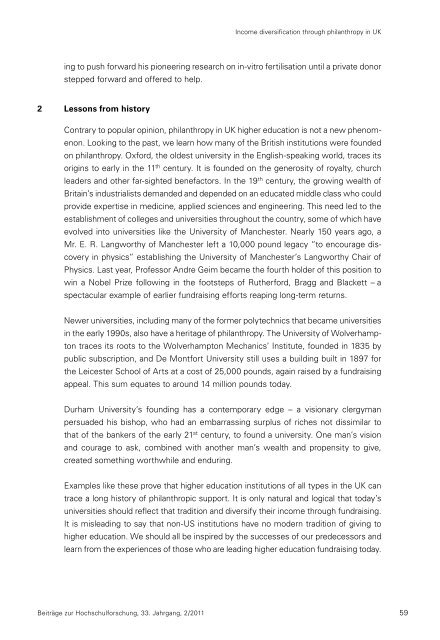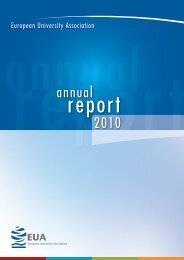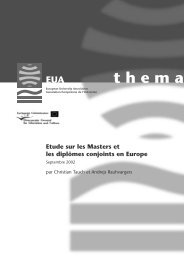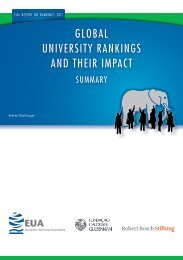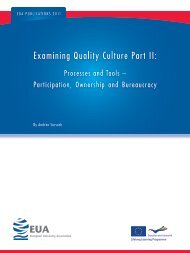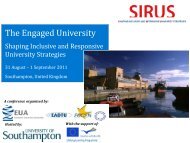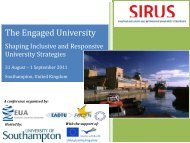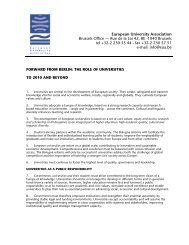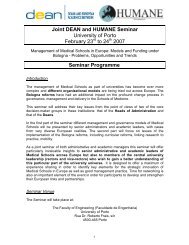Beiträge zur Hochschulforschung - European University Association
Beiträge zur Hochschulforschung - European University Association
Beiträge zur Hochschulforschung - European University Association
You also want an ePaper? Increase the reach of your titles
YUMPU automatically turns print PDFs into web optimized ePapers that Google loves.
Income diversification through philanthropy in UK<br />
ing to push forward his pioneering research on in-vitro fertilisation until a private donor<br />
stepped forward and offered to help.<br />
2 Lessons from history<br />
Contrary to popular opinion, philanthropy in UK higher education is not a new phenom-<br />
enon. Looking to the past, we learn how many of the British institutions were founded<br />
on philanthropy. Oxford, the oldest university in the English-speaking world, traces its<br />
origins to early in the 11 th century. It is founded on the generosity of royalty, church<br />
leaders and other far-sighted benefactors. In the 19 th century, the growing wealth of<br />
Britain’s industrialists demanded and depended on an educated middle class who could<br />
provide expertise in medicine, applied sciences and engineering. This need led to the<br />
establishment of colleges and universities throughout the country, some of which have<br />
evolved into universities like the <strong>University</strong> of Manchester. Nearly 150 years ago, a<br />
Mr. E. R. Langworthy of Manchester left a 10,000 pound legacy “to encourage dis-<br />
covery in physics” establishing the <strong>University</strong> of Manchester’s Langworthy Chair of<br />
Physics. Last year, Professor Andre Geim became the fourth holder of this position to<br />
win a Nobel Prize following in the footsteps of Rutherford, Bragg and Blackett –―a<br />
spectacular example of earlier fundraising efforts reaping long-term returns.<br />
Newer universities, including many of the former polytechnics that became universities<br />
in the early 1990s, also have a heritage of philanthropy. The <strong>University</strong> of Wolverhamp-<br />
ton traces its roots to the Wolverhampton Mechanics’ Institute, founded in 1835 by<br />
public subscription, and De Montfort <strong>University</strong> still uses a building built in 1897 for<br />
the Leicester School of Arts at a cost of 25,000 pounds, again raised by a fundraising<br />
appeal. This sum equates to around 14 million pounds today.<br />
Durham <strong>University</strong>’s founding has a contemporary edge – a visionary clergyman<br />
persuaded his bishop, who had an embarrassing surplus of riches not dissimilar to<br />
that of the bankers of the early 21 st century, to found a university. One man’s vision<br />
and courage to ask, combined with another man’s wealth and propensity to give,<br />
created something worthwhile and enduring.<br />
Examples like these prove that higher education institutions of all types in the UK can<br />
trace a long history of philanthropic support. It is only natural and logical that today’s<br />
universities should reflect that tradition and diversify their income through fundraising.<br />
It is misleading to say that non-US institutions have no modern tradition of giving to<br />
higher education. We should all be inspired by the successes of our predecessors and<br />
learn from the experiences of those who are leading higher education fundraising today.<br />
<strong>Beiträge</strong> <strong>zur</strong> <strong>Hochschulforschung</strong>, 33. Jahrgang, 2/2011 59


